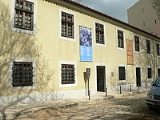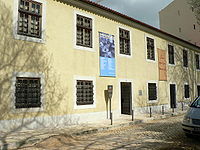
Maria Helena Vieira da Silva
Encyclopedia
Maria Helena Vieira da Silva (June 13, 1908 – March 6, 1992) was a Portuguese-French abstractionist
painter.
with Fernand Léger
, sculpture
with Antoine Bourdelle
, and engraving
with Stanley William Hayter
, all masters in their respective fields. She also created textile designs.
By 1930 Vieira da Silva was exhibiting her paintings in Paris; that same year she married the Hungarian
painter Árpád Szenes
. After a brief sojourn back in Lisbon and a period spent in Brazil during World War II (1940–1947), Vieira da Silva lived and worked in Paris the rest of her life. She adopted French citizenship in 1956. Vieira da Silva received the French government's Grand Prix National des Arts in 1966, the first woman so honored. She was named a Chevalier
of the Legion of Honor in 1979. She died in Paris, France on March 6, 1992.
and the fragmented forms, spatial ambiguities, and restricted palette of cubism
and abstract art
. She is considered to be one of the most important Post-War abstract artists although she is not a "pure" abstract painter. Her work is related to French Tachisme
, American Abstract expressionism
, and Surrealism
—as were many of her contemporaries who were painting in Post-War Paris during the mid to late 1940s and early 1950s. Her paintings often resemble maze
s, cities seen in profile or from high above or even library shelves in what seems to be an allegory
to a never-ending search for Knowledge
or the Absolute
.
 She exhibited her work widely, winning a prize for painting at the São Paulo Art Biennial
She exhibited her work widely, winning a prize for painting at the São Paulo Art Biennial
in São Paulo
in 1961.
She decorated in 1988 the new Cidade Universitária subway station of Lisbon with azulejo
panels.
In November 1994, the Árpád Szenes-Vieira da Silva Foundation was inaugurated in Lisbon, a museum that displays a large collection of paintings by both artists.
Her name sometimes appears written as Maria Elena Vieira da Silva, but the correct version, in Portuguese, is Maria Helena Vieira da Silva.
Abstract art
Abstract art uses a visual language of form, color and line to create a composition which may exist with a degree of independence from visual references in the world. Western art had been, from the Renaissance up to the middle of the 19th century, underpinned by the logic of perspective and an...
painter.
Life
Vieira da Silva was born in Lisbon, Portugal. At the age of eleven she had begun seriously studying drawing and painting at that city's Academia de Belas-Artes. In her teen years she studied paintingPainting
Painting is the practice of applying paint, pigment, color or other medium to a surface . The application of the medium is commonly applied to the base with a brush but other objects can be used. In art, the term painting describes both the act and the result of the action. However, painting is...
with Fernand Léger
Fernand Léger
Joseph Fernand Henri Léger was a French painter, sculptor, and filmmaker. In his early works he created a personal form of Cubism which he gradually modified into a more figurative, populist style...
, sculpture
Sculpture
Sculpture is three-dimensional artwork created by shaping or combining hard materials—typically stone such as marble—or metal, glass, or wood. Softer materials can also be used, such as clay, textiles, plastics, polymers and softer metals...
with Antoine Bourdelle
Antoine Bourdelle
Antoine Bourdelle , originally Émile Antoine Bourdelle, was an influential and prolific French sculptor, painter, and teacher.-Career:...
, and engraving
Engraving
Engraving is the practice of incising a design on to a hard, usually flat surface, by cutting grooves into it. The result may be a decorated object in itself, as when silver, gold, steel, or glass are engraved, or may provide an intaglio printing plate, of copper or another metal, for printing...
with Stanley William Hayter
Stanley William Hayter
Stanley William Hayter , CBE was a British painter and printmaker associated in the 1930s with Surrealism and from 1940 onward with Abstract Expressionism. Regarded as one of the most significant printmakers of the 20th century, in 1927 Hayter founded the legendary Atelier 17 studio in Paris...
, all masters in their respective fields. She also created textile designs.
By 1930 Vieira da Silva was exhibiting her paintings in Paris; that same year she married the Hungarian
Hungary
Hungary , officially the Republic of Hungary , is a landlocked country in Central Europe. It is situated in the Carpathian Basin and is bordered by Slovakia to the north, Ukraine and Romania to the east, Serbia and Croatia to the south, Slovenia to the southwest and Austria to the west. The...
painter Árpád Szenes
Árpád Szenes
Árpád Szenes was a Hungarian-Jewish abstract painter who worked in France.He and Portuguese-French painter Maria Helena Vieira da Silva married in 1930 and became French citizens in the 1950s...
. After a brief sojourn back in Lisbon and a period spent in Brazil during World War II (1940–1947), Vieira da Silva lived and worked in Paris the rest of her life. She adopted French citizenship in 1956. Vieira da Silva received the French government's Grand Prix National des Arts in 1966, the first woman so honored. She was named a Chevalier
Knight
A knight was a member of a class of lower nobility in the High Middle Ages.By the Late Middle Ages, the rank had become associated with the ideals of chivalry, a code of conduct for the perfect courtly Christian warrior....
of the Legion of Honor in 1979. She died in Paris, France on March 6, 1992.
Work
By the late 1950s Vieira da Silva was internationally known for her dense and complex compositions, influenced by the art of Paul CézannePaul Cézanne
Paul Cézanne was a French artist and Post-Impressionist painter whose work laid the foundations of the transition from the 19th century conception of artistic endeavour to a new and radically different world of art in the 20th century. Cézanne can be said to form the bridge between late 19th...
and the fragmented forms, spatial ambiguities, and restricted palette of cubism
Cubism
Cubism was a 20th century avant-garde art movement, pioneered by Pablo Picasso and Georges Braque, that revolutionized European painting and sculpture, and inspired related movements in music, literature and architecture...
and abstract art
Abstract art
Abstract art uses a visual language of form, color and line to create a composition which may exist with a degree of independence from visual references in the world. Western art had been, from the Renaissance up to the middle of the 19th century, underpinned by the logic of perspective and an...
. She is considered to be one of the most important Post-War abstract artists although she is not a "pure" abstract painter. Her work is related to French Tachisme
Tachisme
Tachisme is a French style of abstract painting popular in the 1940s and 1950s. It is often considered to be the European equivalent to abstract expressionism...
, American Abstract expressionism
Abstract expressionism
Abstract expressionism was an American post–World War II art movement. It was the first specifically American movement to achieve worldwide influence and put New York City at the center of the western art world, a role formerly filled by Paris...
, and Surrealism
Surrealism
Surrealism is a cultural movement that began in the early 1920s, and is best known for the visual artworks and writings of the group members....
—as were many of her contemporaries who were painting in Post-War Paris during the mid to late 1940s and early 1950s. Her paintings often resemble maze
Maze
A maze is a tour puzzle in the form of a complex branching passage through which the solver must find a route. In everyday speech, both maze and labyrinth denote a complex and confusing series of pathways, but technically the maze is distinguished from the labyrinth, as the labyrinth has a single...
s, cities seen in profile or from high above or even library shelves in what seems to be an allegory
Allegory
Allegory is a demonstrative form of representation explaining meaning other than the words that are spoken. Allegory communicates its message by means of symbolic figures, actions or symbolic representation...
to a never-ending search for Knowledge
Knowledge
Knowledge is a familiarity with someone or something unknown, which can include information, facts, descriptions, or skills acquired through experience or education. It can refer to the theoretical or practical understanding of a subject...
or the Absolute
Absolute (philosophy)
The Absolute is the concept of an unconditional reality which transcends limited, conditional, everyday existence. It is sometimes used as an alternate term for "God" or "the Divine", especially, but by no means exclusively, by those who feel that the term "God" lends itself too easily to...
.

São Paulo Art Biennial
The São Paulo Art Biennial was founded in 1951 and has been held every two years since. It is the second oldest art biennial in the world after the Venice Biennial , which serves as its role model....
in São Paulo
São Paulo
São Paulo is the largest city in Brazil, the largest city in the southern hemisphere and South America, and the world's seventh largest city by population. The metropolis is anchor to the São Paulo metropolitan area, ranked as the second-most populous metropolitan area in the Americas and among...
in 1961.
She decorated in 1988 the new Cidade Universitária subway station of Lisbon with azulejo
Azulejo
Azulejo from the Arabic word Zellige زليج is a form of Portuguese or Spanish painted, tin-glazed, ceramic tilework. They have become a typical aspect of Portuguese culture, having been produced without interruption for five centuries...
panels.
In November 1994, the Árpád Szenes-Vieira da Silva Foundation was inaugurated in Lisbon, a museum that displays a large collection of paintings by both artists.
Her name sometimes appears written as Maria Elena Vieira da Silva, but the correct version, in Portuguese, is Maria Helena Vieira da Silva.

